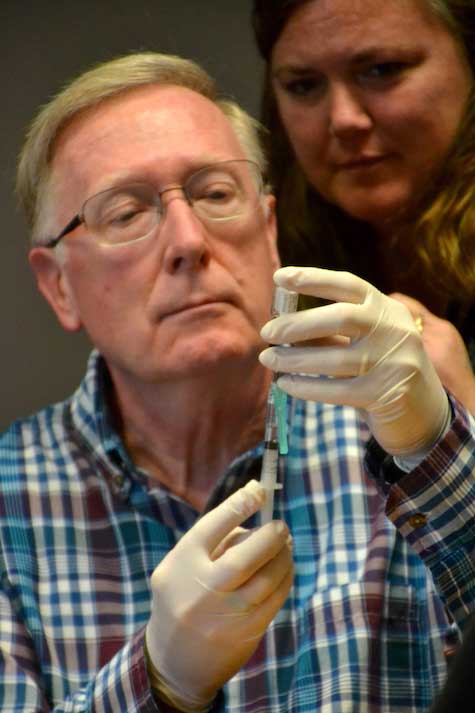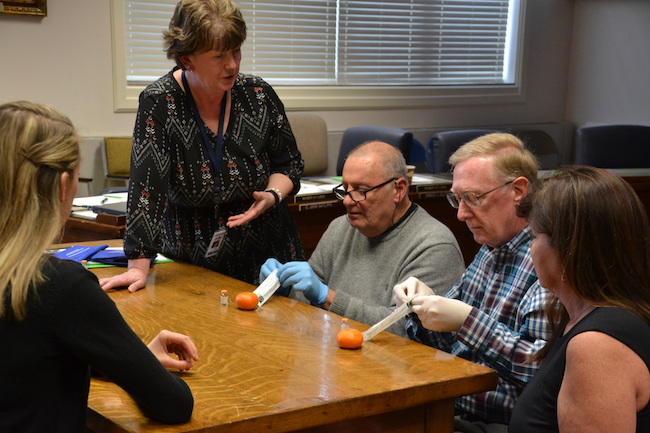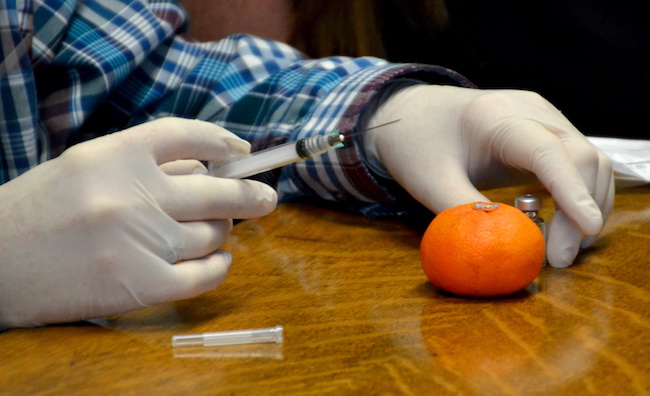3 county legislators take Narcan training

Photos by Tom Rivers: David Callard, chairman of the Orleans County Legislature, checks a shot with a dose of Narcan, which can help block the effects of opioids and reverse an overdose. Callard received training on Narcan from GCASA, including Tracy Zakes, a prevention educator in back.
ALBION – Three Orleans County legislators received training in Narcan on Thursday.
Narcan is a prescription medicine that blocks the effects of opioids and reverses an overdose.
The Genesee-Orleans Council on Alcoholism and Substance Abuse has provided training to about 200 community members in the past two years in administering Narcan. GCASA has trained school nurses, probation officers, GCASA staff and family members of GCASA patients.
Three county legislators – David Callard of Medina, Fred Miller of Albion, and Lynne Johnson of Lyndonville – took the training on Thursday.
“I wanted to set an example with the county staff and public that this is important,” Callard said.
The county, region, state and country are experiencing surges in opioid addictions, overdoses and deaths, said Diana Fulcomer, GCASA prevention educator.
The death rates from accidental overdoses have increased more than 600 percent in the last 10 years in the U.S. from prescription drugs. Accidental overdose deaths increased close to 500 percent in Erie County last year.
A child who ingests an adult opiate painkiller prescription, an elderly person who forgets and takes too much of their opiate painkiller medication and a loved one who struggles with opiate/heroin addiction are a few examples of situations that can lead to an accidental overdose, GCASA said.
Commonly used opioids include heroin, codeine, Demerol, morphine, Darvocet, fentanyl, Dilaudid, methadone, opium, hydrocodone, oxycodone, Levorphanol, Vicodin, OxyContin, Tylenol 3, Tylox, Percocet and Percodan, according to GCASA prevention educators.
The GCASA educators said opioid addiction often starts with prescription pain killer abuse.

Diana Fulcomer (left), a prevention educator with GCASA, advises county legislators on how to administer a shot of Narcan. The legislators include, from left: Fred Miller, David Callard and Lynne Johnson.
GCASA (using information from the state Office of Alcoholism & Substance Abuse Services) said there are are four steps in administering Narcan (Naloxone):
Step 1: Recognize an overdose – A person is unconscious, breathing very slowly, turning blue and not responding when his/her name is yelled or when rubbing knuckles on breastbone.
Step 2: Call 911 – Give address/location, and report your friend or loved one is unconscious or isn’t breathing.
Step 3: If person not breathing, give rescue breaths – Tilt head back, lift chin, pinch nose and then give two quick breaths, then a breath every 5 seconds.
Step 4: Give Narcan – Inject into upper arm or thigh muscle; Repeat after 3-5 minutes if person not waking up; Remind person not to use more drugs; Stay with person until EMS arrives; Place in recover position.
For more information about Narcan and the training to administer, call Sherri Bensley at GCASA in Albion at (585) 589-0055.

The legislators, as part of the training, injected the shot into an orange.










































































